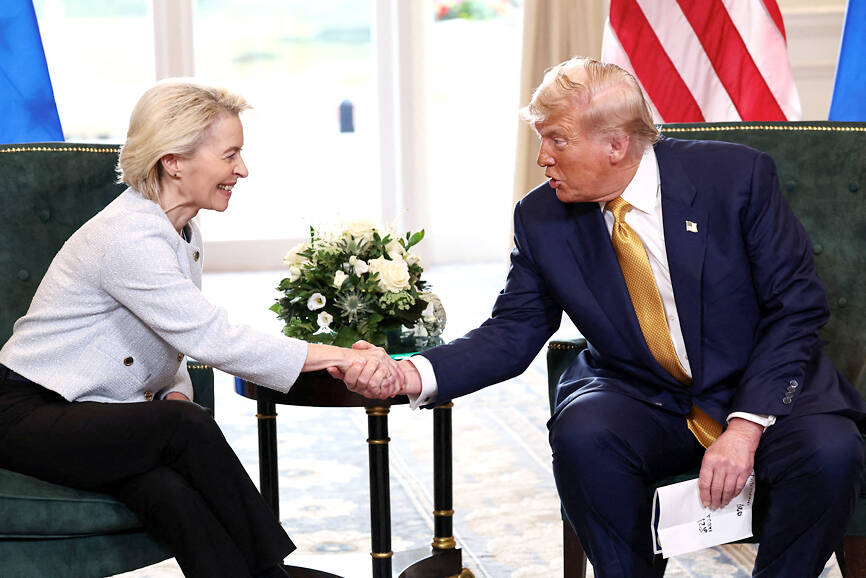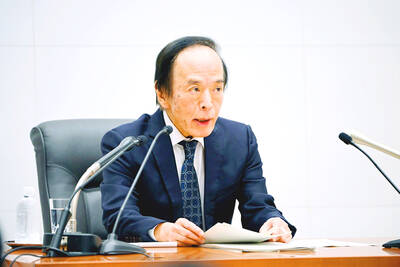The US and the EU agreed on a hard-fought deal that will see the bloc face 15 percent tariffs on most of its exports, including cars, staving off a trade war that could have delivered a hammer blow to the global economy.
The pact was concluded less than a week before a Friday deadline for US President Donald Trump’s higher tariffs to take effect and was quickly praised by several European leaders, including German Chancellor Friedrich Merz and Italian Prime Minister Giorgia Meloni, who called it “sustainable.”
Trump and European Commission President Ursula von der Leyen announced the deal on Sunday at his golf club in Turnberry, Scotland, although they did not disclose the full details of the pact or release any written materials. The 15 percent rates would take effect on Friday, US officials said.

Photo: Reuters
“It’s the biggest of all the deals,” Trump said, while Von der Leyen added it would bring “stability” and “predictability.”
Trump and Von der Leyen also differed on some of the key terms of the deal they announced. The US president said the tariff level would apply to “automobiles and everything else,” but not pharmaceuticals and metals.
The chief of the EU’s executive arm said later at a news conference that the 15 percent rate would be all-inclusive, would not stack on top of industry-specific tariffs and would cover drugs, chips and cars. Metals duties “will be cut and a quota system will be put in place,” she said.
“We have 15 percent for pharmaceuticals. Whatever the decision later on is, of the president of the US, how to deal with pharmaceuticals in general globally, that’s on a different sheet of paper,” Von der Leyen said, adding that the overall rate “is not to be underestimated, but it was the best we could get.”
Senior US officials later said that the two sides agreed on a 15 percent tariff level for the EU’s pharmaceutical exports. A separate probe on pharmaceuticals under Section 232 of the US Trade Expansion Act of 1962 is still coming over the next three weeks, but the EU tariff level would remain at 15 percent, the officials added.
The EU agreed to purchase US$750 billion in US energy products, invest US$600 billion in the US on top of existing expenditures, open up countries’ markets to trade with the US at zero tariffs and purchase “vast amounts” of military equipment, Trump said.
Von der Leyen said no decisions have been made on European wine and spirits, but the matter would be sorted out soon.
The deal does not cover the EU’s steel and aluminum exports, which would remain subject to 50 percent tariffs, senior US officials said.
Meanwhile, aerospace tariffs would remain at zero percent pending the outcome of a Section 232 probe, the officials added.
The transatlantic pact removes a major risk for markets and the global economy — a trade war involving US$1.7 trillion worth of cross-border commerce — even though it means European shipments to the US are getting hit with a higher tax at the border.
The goals, Trump said, were more production in the US and wider access for US exporters to the European market. Von der Leyen acknowledged part of the drive behind the talks was a reordering of trade, but cast it as beneficial for both sides.
“The starting point was an imbalance,” Von der Leyen said. “We wanted to rebalance the trade we made, and we wanted to do it in a way that trade goes on between the two of us across the Atlantic, because the two biggest economies should have a good trade flow.”
Several exporters in Asia, including Indonesia, the Philippines and Japan, have negotiated reciprocal rates between 15 percent and 20 percent, and the EU saw Japan’s deal for 15 percent on autos as a breakthrough worth seeking as well. Washington’s talks also continue with Switzerland, South Korea and Taiwan.
Trump said he is “looking at deals with three or four other countries,” but “for the most part,” others with smaller economies or less significant trading relationships with the US would receive letters simply setting tariff rates.

Taiwan’s long-term economic competitiveness will hinge not only on national champions like Taiwan Semiconductor Manufacturing Co. (TSMC, 台積電) but also on the widespread adoption of artificial intelligence (AI) and other emerging technologies, a US-based scholar has said. At a lecture in Taipei on Tuesday, Jeffrey Ding, assistant professor of political science at the George Washington University and author of "Technology and the Rise of Great Powers," argued that historical experience shows that general-purpose technologies (GPTs) — such as electricity, computers and now AI — shape long-term economic advantages through their diffusion across the broader economy. "What really matters is not who pioneers

In a high-security Shenzhen laboratory, Chinese scientists have built what Washington has spent years trying to prevent: a prototype of a machine capable of producing the cutting-edge semiconductor chips that power artificial intelligence (AI), smartphones and weapons central to Western military dominance, Reuters has learned. Completed early this year and undergoing testing, the prototype fills nearly an entire factory floor. It was built by a team of former engineers from Dutch semiconductor giant ASML who reverse-engineered the company’s extreme ultraviolet lithography (EUV) machines, according to two people with knowledge of the project. EUV machines sit at the heart of a technological Cold

TAIWAN VALUE CHAIN: Foxtron is to fully own Luxgen following the transaction and it plans to launch a new electric model, the Foxtron Bria, in Taiwan next year Yulon Motor Co (裕隆汽車) yesterday said that its board of directors approved the disposal of its electric vehicle (EV) unit, Luxgen Motor Co (納智捷汽車), to Foxtron Vehicle Technologies Co (鴻華先進) for NT$787.6 million (US$24.98 million). Foxtron, a half-half joint venture between Yulon affiliate Hua-Chuang Automobile Information Technical Center Co (華創車電) and Hon Hai Precision Industry Co (鴻海精密), expects to wrap up the deal in the first quarter of next year. Foxtron would fully own Luxgen following the transaction, including five car distributing companies, outlets and all employees. The deal is subject to the approval of the Fair Trade Commission, Foxtron said. “Foxtron will be

INFLATION CONSIDERATION: The BOJ governor said that it would ‘keep making appropriate decisions’ and would adjust depending on the economy and prices The Bank of Japan (BOJ) yesterday raised its benchmark interest rate to the highest in 30 years and said more increases are in the pipeline if conditions allow, in a sign of growing conviction that it can attain the stable inflation target it has pursued for more than a decade. Bank of Japan Governor Kazuo Ueda’s policy board increased the rate by 0.2 percentage points to 0.75 percent, in a unanimous decision, the bank said in a statement. The central bank cited the rising likelihood of its economic outlook being realized. The rate change was expected by all 50 economists surveyed by Bloomberg. The